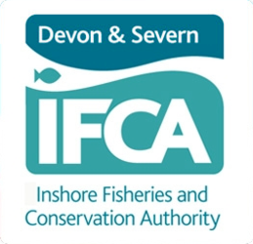Whelks
Page review/updated 11/10/2023
THE WHELK FISHERY IN D&S IFCA’S DISTRICT
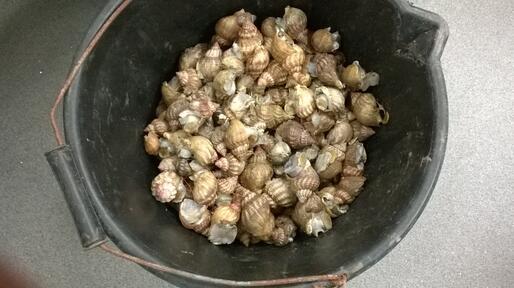
BIOLOGY
The common whelk (Buccinum undatum) is a gastropod mollusc that is widely fished commercially around the UK. They inhabit both rocky/gravelly and muddy/sandy sea beds from the low water mark of the intertidal zone to depths of 1200m, but usually prefers depths of 20-30m. The species has two distinct separate sexes. The males are distinguished by a large muscular penis which is absent from the females. Whelks vary in size distribution, maturation size and morphology and have a lifespan of around 10-12 years. They have a slow growth rate, with the annual shell growth rate decreasing with increasing age. The age of onset of sexual maturity is highly variable ranging from 3.9 to 6.9 years, which can cause challenges for management of this fishery.
European populations have been reported to breed during autumn and winter. Females generally begin to lay their eggs once ambient water temperatures fall below 9 degrees. In the UK whelks are close to their southern limit as warmer temperatures are thought to be a limiting factor to reproduction. Eggs are fertilised internally, and the female will lay clusters of yellow egg capsules on hard benthic substrate such as rocks. Larval development occurs within the egg capsules and juveniles emerge after three to eight months and crawl onto the substrate. This reproductive strategy (no pelagic phase) results in limited dispersal potential. In addition, adult whelks have been shown to be relatively sedentary and exhibit limited movements. These two life history traits make the common whelk vulnerable to localised depletion and may lead to longer recovery times if over-exploitation did occur.
THE FISHERY
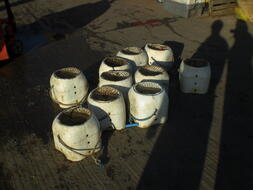
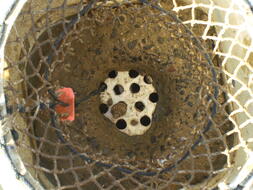
Fishing effort for whelks (Buccinum undatum) in the UK has been increasing relatively quickly over the recent years. Whelk landings in terms of tonnage and value doubled between 2002 (8,687 tonnes worth £4million) and 2012 (16,000 tonnes worth £10.8million). Ilfracombe, Teignmouth and Exmouth are the three main landing ports within the D&S IFCA’s District for the whelk fishing sector.
In 2019 landings into Ilfracombe were 228.40 tonnes worth £297,504; into Teignmouth 277.34 tonnes of whelks were landed worth £354,003 and 103.54 tonnes were landed into Exmouth worth £135,495. Landings into Brixham are significant but may come from vessels operating outside of D&S IFCA’s District. In 2019 141.17 tonnes were landed with a value of £197,098. The increase in effort for this fishery is thought to be attributed to a boom in demand in the Far East, particularly in South Korea. The consistent increase in fishing effort has raised concerns over the sustainability of the fishery as stocks have never been formally assessed.
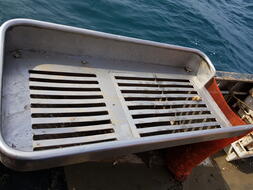
Fishers use specially designed whelk pots baited with fish and shellfish. They are set using a number of pots attached to one string. Once hauled the catch from each pot is passed through a riddle, which is a piece of equipment made up of parallel metal bars. The specific spacing between the bars allows undersized whelks to fall through, be collected and returned to the sea.
European whelk fisheries are subject to measures defined under the Common Fisheries Policy (CFP) to aim for safeguarding from overfishing. A Minimum Conservation Reference Size (MCRS) of 45mm currently applies in England, being the only national management measure for this fishery.
RESEARCH AND MANAGEMENT
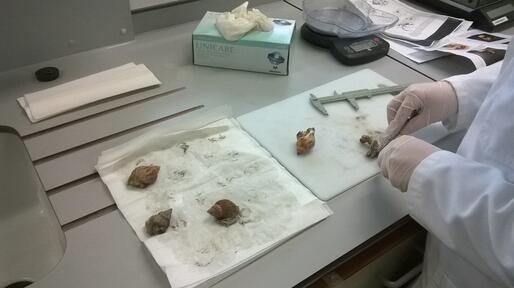
In 2012-13 Cefas undertook a study to determine the size of maturity (SOM) for both sexes of whelks in all the main fisheries around the country, including Exmouth and Ilfracombe in the D&S IFCA’s District, using one-off samples from each of these ports. The results of this survey indicated that for the sample taken from Ilfracombe the SOM was 75.5mm for both females and males, and for the Exmouth sample the SOM was 72.4mm for females and 69.2mm for males. This implies that the EU MCRS of 45mm is currently doing little to protect the spawning stocks and, therefore, the sustainability of the populations.
In 2013 D&S IFCA officers collected monthly samples, over the course of a year, from Exmouth and Ilfracombe, in order to determine an appropriate MCRS for whelks and identify the time of year when the whelks breed and spawn within the D&S IFCA’s District. The 2015 report found that estimates of SOM by shell height were 69.3mm for females and 70.9mm for males in Exmouth and 76.5mm for females and 76.4mm for males in Ilfracombe. It also highlighted that both spawning in females and copulation in males in Exmouth appears to take place in the winter between December to February. Whereas females appear to spawn in November and male copulation takes place throughout November to January in Ilfracombe. However, samples could not be collected in January, therefore the extent of the spawning time could not be identified.
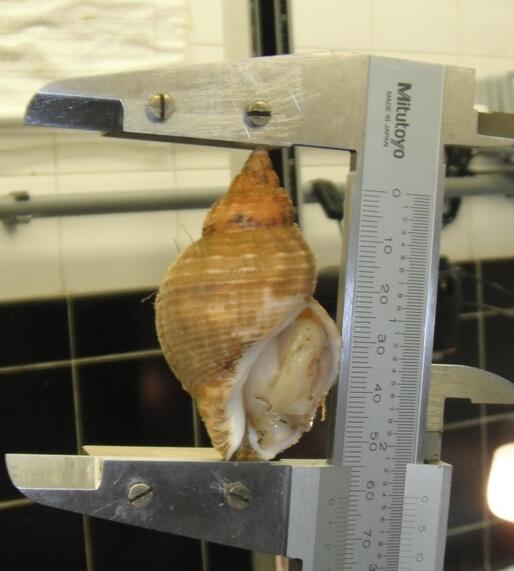
Following this original study to identify the SOM of the common whelk, landed into Exmouth and Ilfracombe, a request to the IFCA was made by a local fisher who pots for whelks in Start Bay. He believed whelks were smaller in this area and, therefore, the results of the original study would not be representative of his catch. Therefore D&S IFCA conducted a second survey with samples being collected from Start Bay. This 2016 report found that estimates of SOM by shell height were 57.8 for females and 64.4 for males.
The results from the 2015 and 2016 report indicated that the EU MCRS for whelks of 45mm is not adequate to protect the spawning stock within the D&S IFCA’s District. As a result, D&S IFCA introduced new management in November 2018 through its Potting Permit Byelaw’s permit conditions, and raised the MCRS of whelks within the District to 55mm, followed by another10mm increase to 65mm in November 2020.
In 2017 and 2018 D&S IFCA officers collected further whelk samples in December and January respectively to fill the data gaps from the 2015 report in order to accurately identify the breeding season. A report, identifying the breeding season was produced in 2019 and suggests the peak breeding activity in Exmouth occurs during November and December and in October and November in Ilfracombe. Further management options for the fishery in the future could therefore include a closed season covering this period. However, D&S IFCA needs to consider the social and economic impacts of a closed season alongside the need to protect the stock and allow for the sustainability of the fishery.
FISHERIES RESEARCH AND MANAGEMENT PLAN FOR WHELK
D&S IFCA has developed Fisheries Research and Management Plans (FRMPs), including one specifically for whelk in the north of D&S IFCA’s District. The whelk FRMP aims to bridge the gap between current, species-focused fisheries management and a more ecosystem-based approach at an appropriate scale. It provides an ecosystem-based review of the ecology, fisheries and management for whelk within the North Devon Marine Pioneer area. This approach integrates local and historical knowledge with scientific research outcomes, building the knowledge base for sustainable ecosystem-based management at an appropriate spatial scale, and highlighting current knowledge gaps to inform future research.
